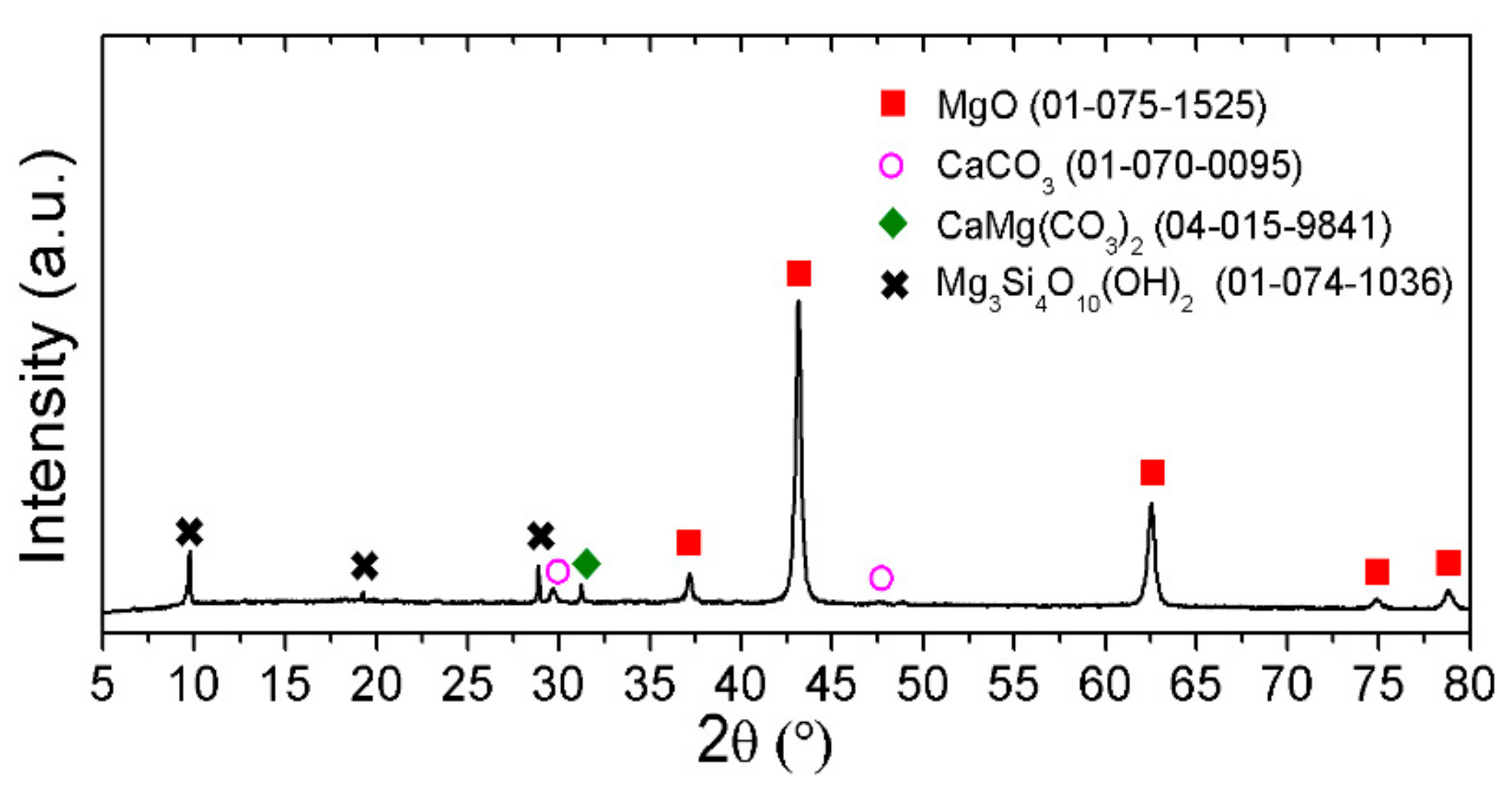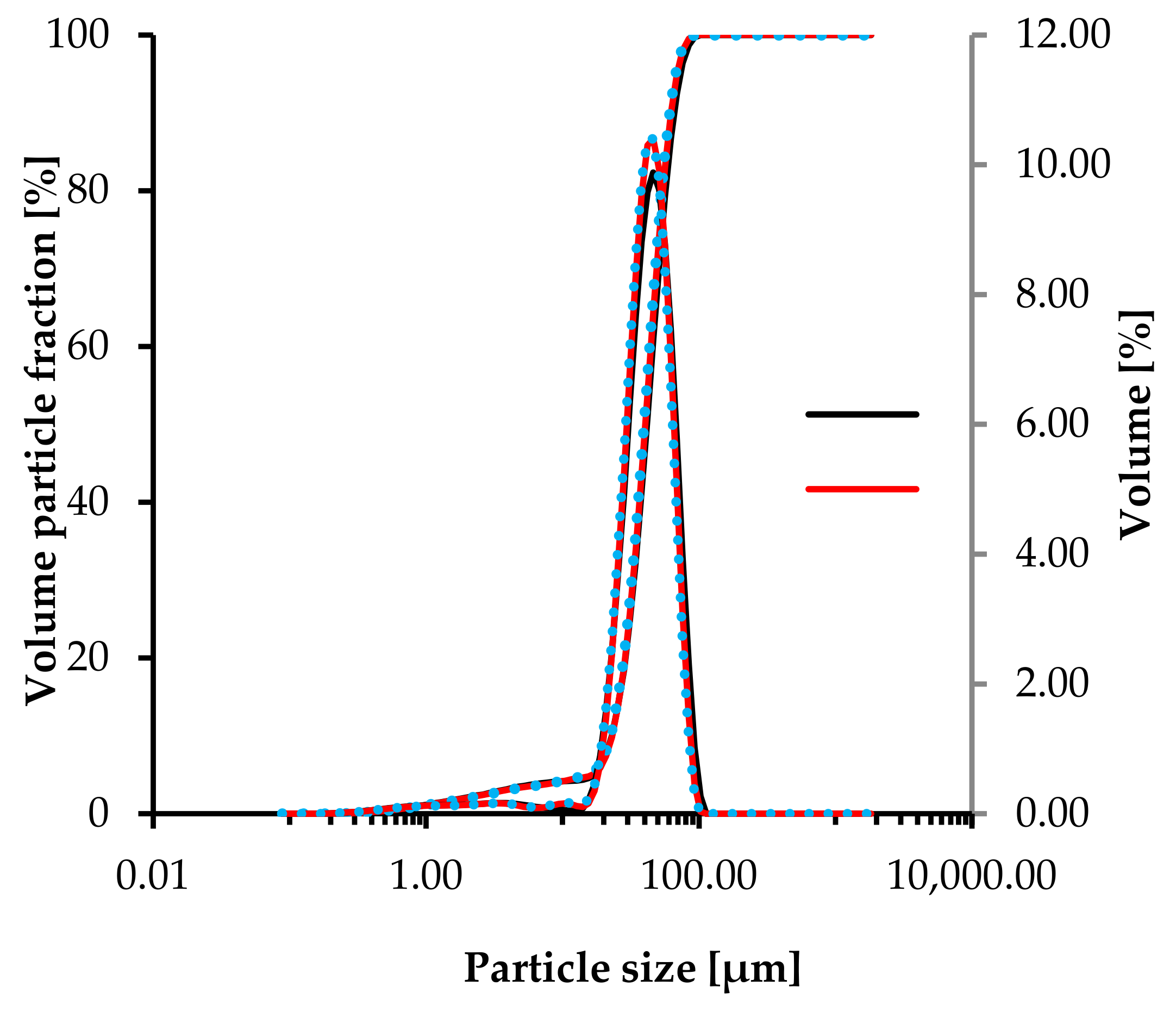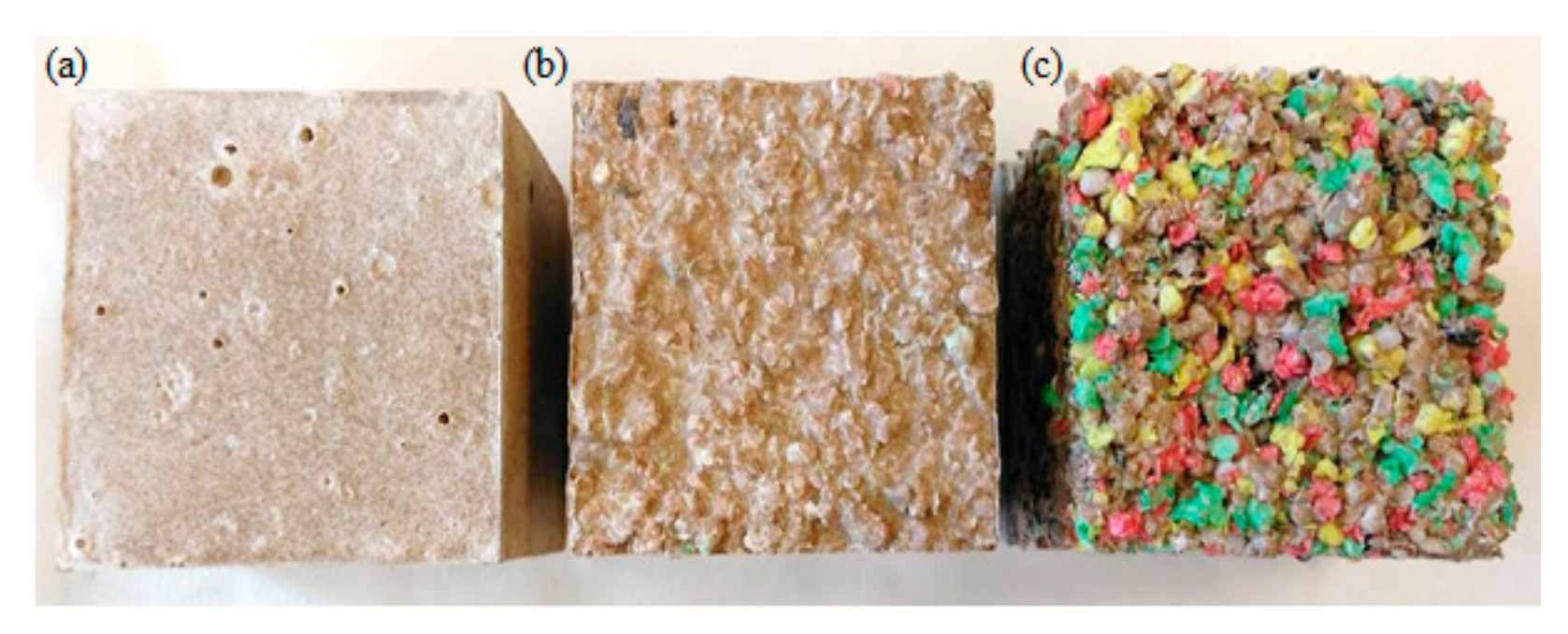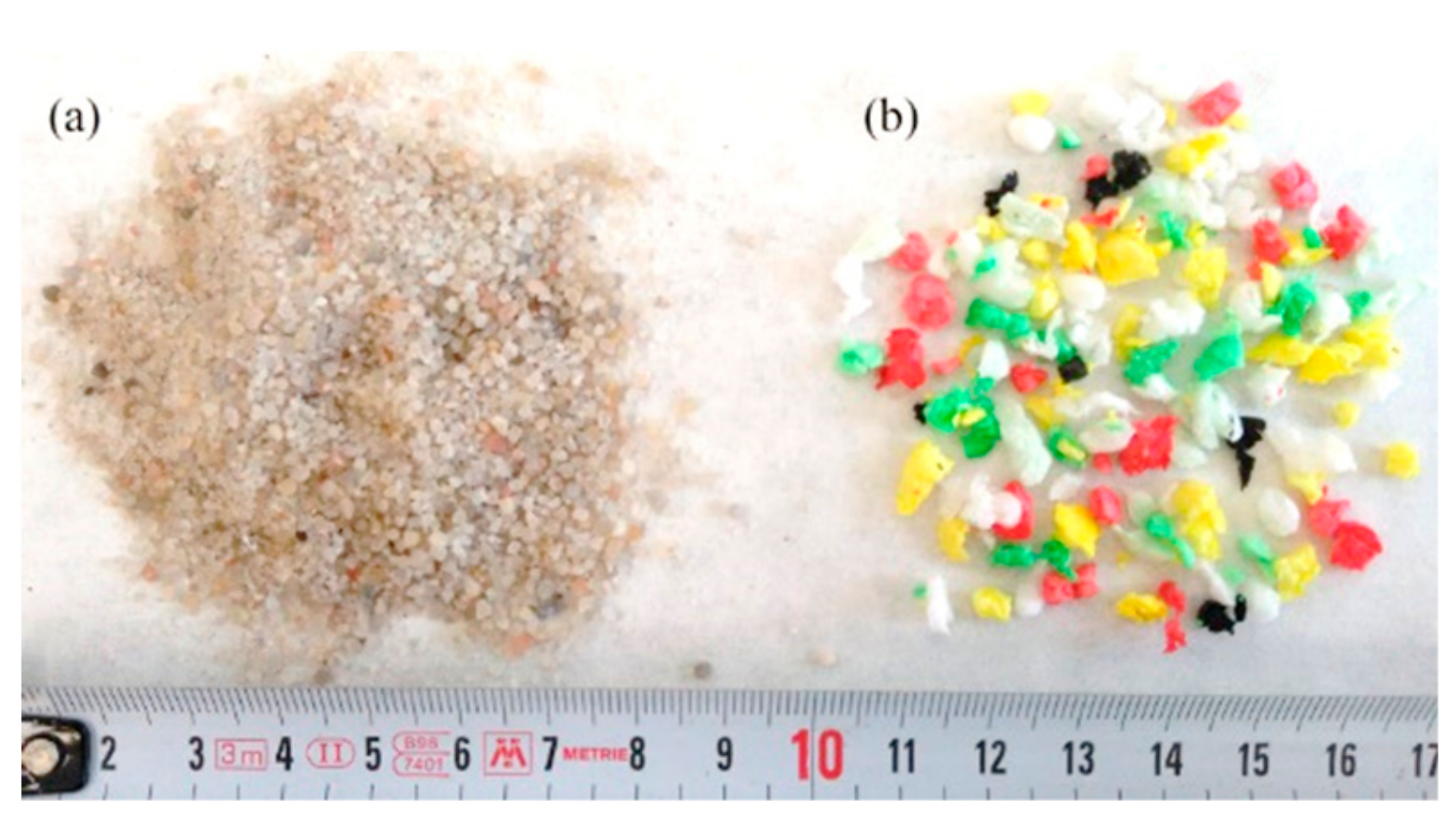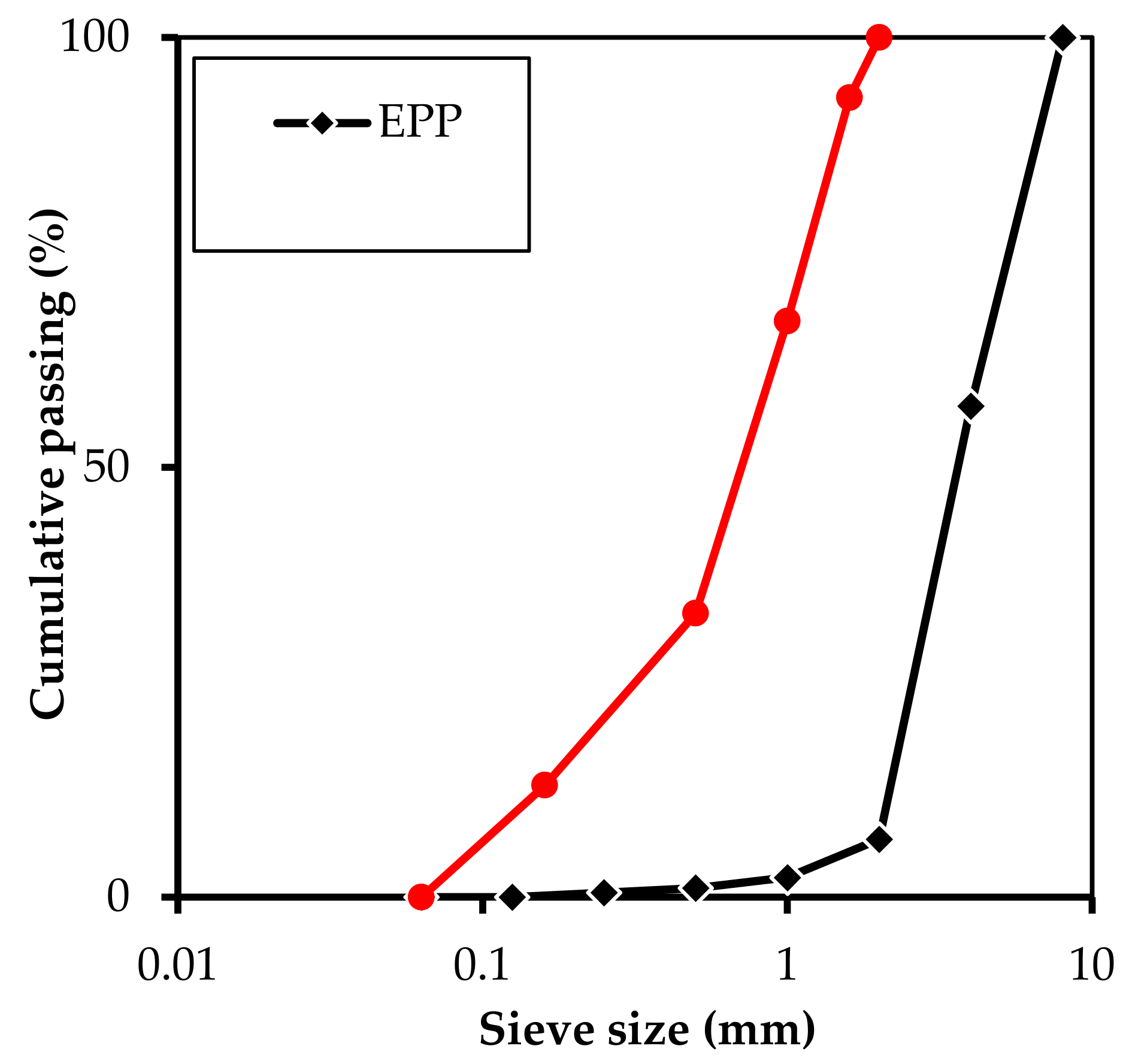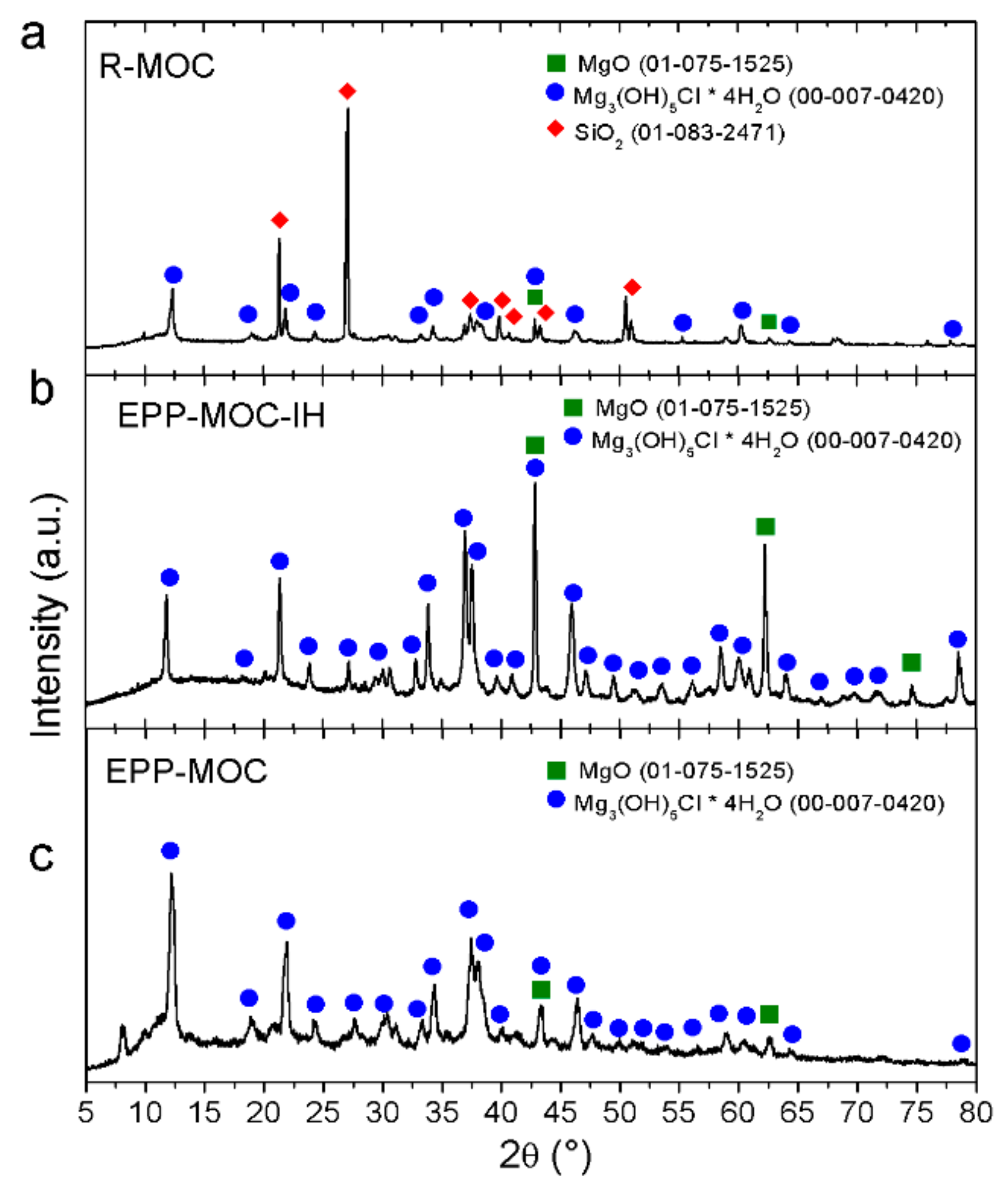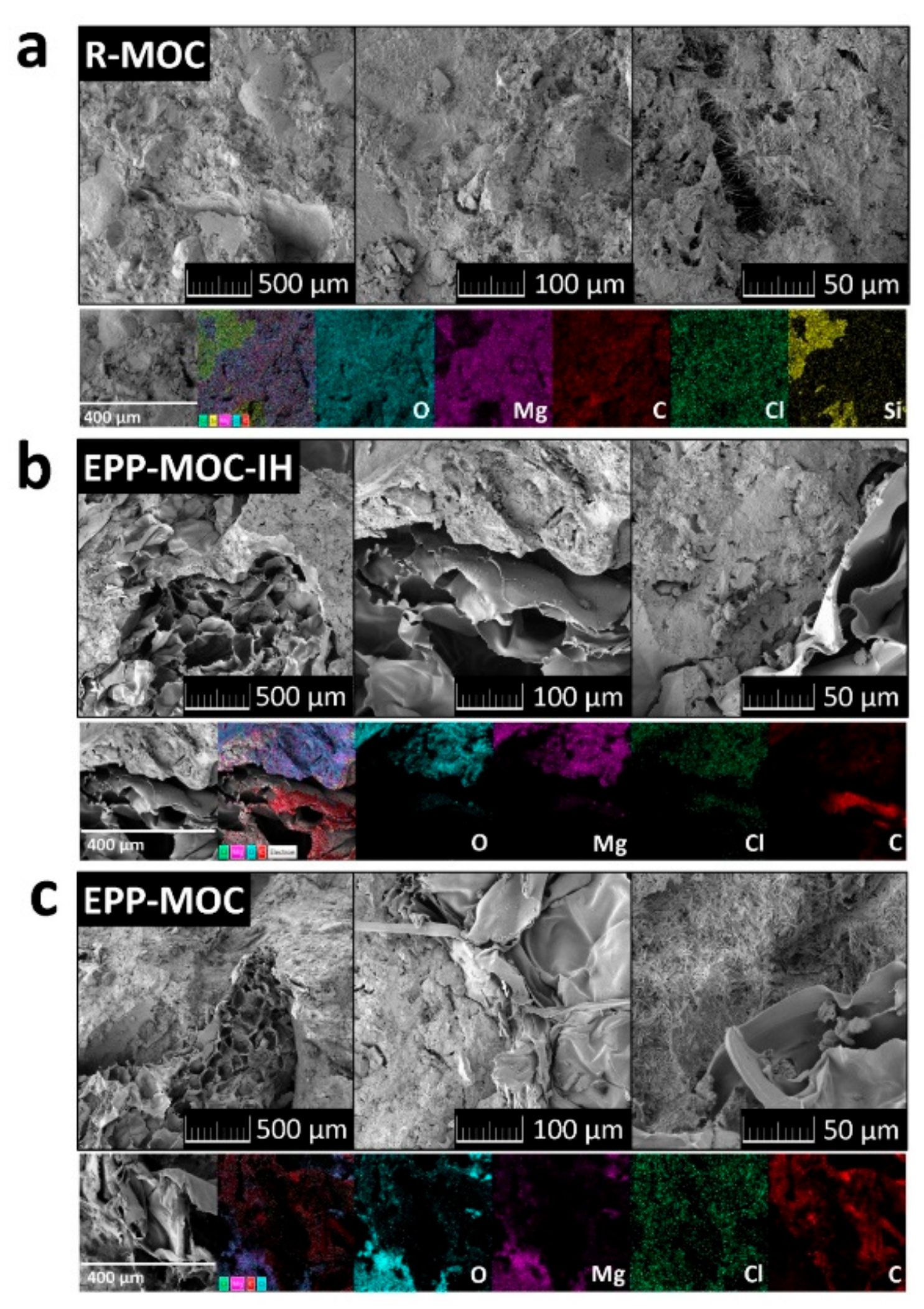1. Introduction
Increasing concentrations of global greenhouse gas (GHG) emissions (especially CO
2), worldwide energy use, and amount of waste constitute currently the largest environmental problems. A large volume of CO
2 emissions can be attributed to building industry, whether related to construction materials production or energy needed for heating and cooling of insufficiently insulated buildings [
1,
2]. For example production of Portland cement (PC) contributes to circa 5–7% of the global CO
2 emissions [
3,
4].
At present, there are efforts to find an alternative to PC that would have a low carbon footprint. One of the candidates may be cements based on the magnesium oxide (MgO). Magnesium oxychloride cement (also known as Sorel cement) is formed by the reaction of a light-burnt MgO powder with a solution of magnesium chloride (MgCl
2) [
5], where the light-burnt (also called caustic c) MgO is produced by calcination of magnesite (MgCO
3) at a temperature of circa 750 °C [
6]. This lower temperature, compared to ~1450 °C used in the production of Portland clinker, allows the use of alternative fuels [
3]. MOC cement-based composites are able to absorb high amount of CO
2 from the atmosphere during their service life to form carbonates and hydroxycarbonates, which leads to their denser microstructure and to higher strength of resulting material [
4,
7]. The production of MgO from magnesite releases more CO
2 per ton than in the production of Portland cement (1.7 t of CO
2/t of MgO vs. 1 t CO
2/t of PC) [
3]. However, taking into account the carbonation of the MOC cement composites, when MOC is able to sequestrate more than half of the CO
2 produced during MgCO
3 calcination (the resulting CO
2 emissions decreased therefore to around 0.5–0.6 t of CO
2/t), and given the total environmental impact during the life cycle of MgO ascertained by LCA, the MOC cement can be considered as environmentally friendly material [
3].
Among superior properties of MOC cement composites are: early compressive strength, excellent fire resistance, low alkalinity (pH of 8–10), short setting time, and anti-abrasion performance [
8,
9]. MOC cements are also known by their ability to incorporate a higher amount of various fillers compared to PC, namely granite waste [
10], fly ash [
10,
11], cenospheres derived from the fly ash [
12], biomass ash [
13], wood [
6], recycled tire rubber [
14], and waste plastics [
15]. Currently, MOC cement is used for the production of industrial floors, for ornamental applications, stucco, grinding wheels, and for different types of panels used for fire protection, as decoration or for sound and thermal insulation [
7,
16]. As an air-dried cementing material, MOC cement composites lose their compressive strength after immersion in water because of the decomposition of hydration products. This limits their wider use in construction sector [
9,
17]. In literature, there are studies that report on improving the poor water resistance of MOC cement. Authors investigated the use of additives as soluble phosphates [
18], fly ash [
11,
17,
19,
20], rice husk ash with addition of phosphoric acid, calcium lignosulfonate, and acrylic emulsion [
21], the phosphoric acid [
22,
23], silica fudehume [
19], and glass powder [
21]. The evaluation of the MOC cement composites water-resistance is to date done only by the compressive strength measurement before and after the immersion in water. However, in the building practice it is also necessary to know other important and for specific applications even crucial parameters of construction materials, such as the water- and water vapor transport properties, heat transport, and storage properties, etc.
As a result of plastics versatility, durability, light-weight, and other intrinsic properties, the plastics demand is still increasing worldwide. The world plastic production was 359 million tons in 2018 and the European production constituted of approx. 17% of this amount [
24]. As regards the demand for plastics in terms of the type of resin in Europe in 2017, on the first place was polypropylene (PP) with the 19.3%, followed by the low-density polyethylene (LD-PE) with 17.5% [
25]. Among the foamed polymers, expanded polypropylene (EPP) has one of the largest worldwide productions. It is known particularly for its impact absorption, thermal insulation parameters, and a high strength to weight ratio. EPP has homogenous, closed cell structure and it is characterized by the good chemical and heat resistance. Unlike the foam polystyrene, it does not emit toxic gases when burned. The most common applications of EPP include packaging, automotive and industrial segments and safety components. The thermal insulation or acoustic properties of EPP are used in the construction of flooring parts in the building industry [
26,
27].
Lahtela et al. [
28] reported on PE and PP polymers as the most common plastics in waste streams coming from construction and demolition waste and from mechanically separated plastic waste from a sorting plant respectively. As the low biodegradability is also one of the properties of plastics, it is necessary to devise suitable end-of-life options for large quantities of plastics waste. Among the extensively studied recycling pathways are the incorporation of plastics waste particles as aggregate into Portland cement-based construction materials, which generally led to decrease of the unit weight and to improvement of the thermal insulation performance of the resulting material, but it is also associated with the reduction of the strength parameters [
29,
30,
31,
32]. The research on the replacement of natural silica aggregate in MOC cement composites with plastics waste aggregate reported, e.g., by Záleská et al. [
15] is rather rare.
To date, only few studies about the thermal performance of MOC cement composites were published. Xu et al. (2016) reported on the decrease of the thermal conductivity of MOC mortars with the addition of cenospheres. Zgueb et al. [
33] observed the low thermal conductivity of MOC cement blended with the polyvinyl acetate polymer (PVAc).
With respect to the lack of knowledge about the application of waste plastics as aggregate in MOC cement concrete, this study is focused on the assessment of MOC cement composites containing waste expanded polypropylene (EPP) particles as a full replacement of silica sand. For the improvement of water-resistance parameters, the inner (calcium stearate and sodium oleate) and surface (boiled linseed oil) hydrophobic agents were used. The produced materials were investigated in terms of their mineralogical composition, structural, mechanical, thermal, water-, and water vapor transport properties. The main aim was to develop lightweight environmentally friendly material with a reduced CO2 emission footprint, characterized by the enhanced thermal insulation parameters and resistance to water penetration, which could be potentially used as a part of floors, ceilings or wall panels.
3. Results and Discussion
The results of the grain-size analysis of silica sand and EPP aggregate are illustrated in
Figure 5. According to the grain size curves, the EPP grains were found smaller than 8 mm and diameter of silica sand particles ranged from 0.063 μm to 2 μm. As further processing of EPP to obtain finer particles was refused in order to ensure low cost and low energy embedded in raw materials, the granulometry of EPP was considered as good in general for substitution of sand in composition of MOC cement composites.
For the reduction of the thermal conductivity values of the tested MOC cement composites it was desirable to select the filler having a low thermal conductivity compared to silica sand commonly used in the construction industry. Thermal and physical properties of both investigated aggregates are summarized in
Table 4.
The longer the time of compaction, the higher thermal conductivity and volumetric heat capacity values were measured. It was due to the increasing packing density with compaction and reduction of air volume between the aggregate particles. As expected, the EPP particles in comparison with those of silica sand exhibited significantly lower heat transport and heat storage. It corresponded with their low specific density, chemical origin, and structure. Nevertheless, for the practical purposes, the low thermal conductivity of EPP is beneficial for the production of lightweight MOC cement composites with an improved thermal insulation function. In
Table 5, the workability of fresh mixtures expressed in terms of flow diameter is given.
Generally, the workability of fresh mixtures affects particularly the amount and size of used filler. The shape of the particles also plays a role [
32,
42]. Results showed that mixtures containing EPP with the higher particle size and expected higher specific surface compared to those of silica sand exhibited considerably reduced workability than the control mixture with silica filler. However, for the intended application of MOC cement composites in thermal insulation floor layers or prefabricated panels and slab with EPP was the achieved workability quite sufficient. The workability of mixtures EPP-MOC and EPP-MOC-IH was almost the same, hydrophobic agents had no clear effect on the flow.
In
Table 6, the structural parameters of the developed MOC cement composites are summarized. The observed R-MOC bulk density value of 2130 kg·m
−3 was similar as the dry density of 2142 kg·m
−3 reported for reference MOC composite by Xu et al. [
12]. With the addition of the EPP aggregate, the bulk density of composites significantly decreased to 42.6% and 43.5% for EPP-MOC and EPP-MOC-IH respectively, compared to R-MOC. It can be explained by the lower specific density of EPP particles (see
Table 4). According to EN 206-1 [
43], the developed EPP-MOC and EPP-MOC-IH may be classified based on their bulk densities as lightweight concretes in class LC 1.0. The porosity of MOC cement composites containing EPP aggregate increased compared to R-MOC. Similar behavior can be found in literature regarding the incorporation of different kind of plastics into a matrix based on Portland cement [
32,
44]. The lightening of high-density structure by the use of the EPP aggregate resulted in lightweight composites with high porosity which extended their application potential in the construction sector. The used hydrophobic admixtures had almost no effect on structural characteristics of composites with EPP.
The comparison of strength characteristics of examined composites is given in
Table 7.
Mechanical parameters of MOC composites are mainly dependent on used molar ratios of MgO/MgCl
2 and H
2O/MgCl
2, which governs the formation of binding phases and amount of unreacted raw materials [
45]. For mortars, the parameters of filler and ratio of filler/binder should be moreover considered. The replacement of sand with EPP aggregate led to the significant reduction in all strength parameters. The compressive strength reductions of EPP-MOC and EPP-MOC-IH were 90% and 88%, respectively, as compared to control material R-MOC. This strength decrease is in accordance with the density and porosity data (
Table 6). Similarly as in our case, many researchers stated that the incorporation of plastics aggregate of varying shape, kind, and amount causes the loss of mechanical resistance in the composites based on the Portland cement [
30,
32,
45]. Accordingly, the decrease of compressive strength of MOC cements containing different additives was reported by Zgueb [
33].
The typically higher flexural/compressive strength ratio of MOC composites compared to that based on the Portland cement was observed for all developed MOC samples. It can be anticipated that the use of smaller EPP particles would increase the mechanical resistance of the final composites. The improvement in strength parameters might by possible also by vibrating the fresh casted specimens.
The decrease in the thermal transport and storage parameters of MOC composites with EPP aggregate content is obvious from
Table 8.
The great drop in the thermal conductivity values noticed for materials EPP-MOC and EPP-MOC-IH were 83.7% and 83.3%, respectively, compared to R-MOC. In the case of the volumetric heat capacity, a decrease of ~12% was observed for MOC composites containing EPP. Xu et al. [
12] reported on the reduction of thermal conductivity of MOC-based composites with addition of cenospheres derived from fly ash. For cenospheres, addition in the amount of 5, 15, and 25% by weight of the magnesia powder, they observed the thermal conductivity values reduced by 16, 21 and 32%, respectively, as compared to the reference sample without cenospheres. In our case, the deceleration of heat transport by the use of the substitution of silica sand with crushed EPP was much higher. In summary, the main parameters that affect the resulted thermal properties of developed MOC composites were the amount and type of used aggregates, thermal parameters of the aggregates themselves, and the porosity of the composites which significantly increased because of the use of EPP particles. One should take into account the fact that the obtained thermo-physical parameters were measured on dried samples only and the exposure of the studied materials to the real operations conditions of buildings will partially reduce their thermal insulation capability because of the presence of adsorbed water vapor molecules.
The resulting values of water transport properties are shown in
Table 9. In the water sorptivity test, samples with inner (IH) and surface (LO) hydrophobic treatment were examined. Unfortunately, the water suction experiment was not conducted for control R-MOC composite without any hydrophobic treatment because the samples in contact with water deteriorated by the excessive moisture presence. As the specimens exhibited volume changes and cracking, it was not possible to evaluate the measured data.
The values of liquid water transport properties for all tested materials were very low. The reference MOC composite had the lowest water absorption among the samples tested. The increased porosity of the MOC composites with EPP (
Table 6) resulted in a higher water absorption coefficient and water sorptivity. Comparing EPP-MOC samples having inner and surface hydrophobic treatment, the water absorption coefficient was lower for samples treated with boiled linseed oil. However, inner hydrophobic agent provided water-repellent effect both on the surface and in the entire material treated.
No data on hygric properties of MOC cement composites for comparison of our results were found in common literature sources. Generally, hydrophobic treatment significantly affects the water transport properties. For the Portland cement-based composites having porosity of 14.0%, which is similar to R-MOC sample (13.4%), Záleská et al. [
32] reported on the water absorption coefficient of 0.0347 kg·m
−2·s
−1/2 which was more than two orders of magnitude higher than measured for R-MOC-LO. This comparison clearly validated high effectiveness of both inner and surface hydrophobization. Based on that high resistance to moisture attack can be estimated for MOC cement composites treated with the tested chemical additives.
Table 10 shows the water vapor transmission parameters of the investigated MOC cement composites. The water vapor transmission experiments were done on samples without any hydrophobic treatment and on samples with inner and surface hydrophobic treatment. Comparing the MOC composites without hydrophobisation, the water vapor diffusion coefficient of EPP-MOC was about 10% higher than that of the R-MOC sample. The surface treatment with boiled linseed oil reduced the water vapor diffusion coefficient by almost 43% and 12% for reference sample and sample with EPP, respectively. In the case of the inner hydrophobic treatment, EPP-MOC and EPP-MOC-IH exhibited very similar water vapor transmission parameters which pointed out the fact that the inner hydrophobisation predominantly affected the transport of liquid water and not the water vapor properties. This finding is crucial for practical use of the developed lightweight composites as the permeability for water vapor eliminates the possible condensation problems and health risks of the indoor environment, such as respiratory diseases, allergies, etc.
The phase composition of prepared composites was measured using XRD (see
Figure 6). Presence of MOC phase (ICDD 00-007-0420) was confirmed in all three samples. The reaction between MgCl
2 and MgO followed the equation below:
All samples contained over-stoichiometry of MgO (ICDD 01-075-1525), hence MgO was present in all samples after the complete depletion of magnesium chloride in the reaction mixture. This was expected as MgO was used partially as filler. Sample R-MOC contained mainly quartz (ICDD 01-083-2471) and MOC phase and some residual MgO. Sample R-MOC contained mainly quartz and MOC phase. Also some residues of MgO were present. Sample EPP-MOC-IH contained two major phases: MOC and MgO. The last sample EPP-MOC contained mainly MOC phase and only very low amount of MgO.
The microstructure of prepared composites was measured using SEM and the results are shown in
Figure 7. In all samples, the needle-like structures typical for MOC phase were detected. The boundaries between the matrix and EPP (samples EPP-MOC-IH and EPP-MOC) are highly compact without cracks or other defects. Selected areas of composites were also analyzed using EDS. While the chemical composition varies significantly from region to region, the elemental composition values are not shown here. However, according to elemental maps the grain boundaries between EPP and MOC matrix are clearly visible.
